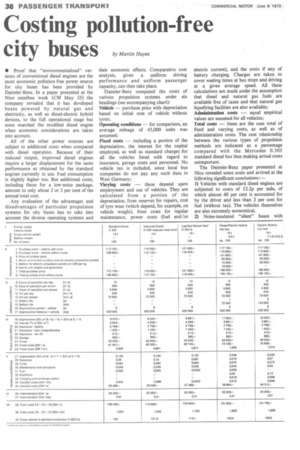Costing pollution-free
Page 38

Page 39

If you've noticed an error in this article please click here to report it so we can fix it.
city buses by Martin Hayes • Proof that "environmentalized" versions of conventional diesel engines are the most economic pollution-free power source for city buses has been provided by Daimler-Benz. In a paper presented at the Nice omnibus week (CM May 25) the company revealed that it has developed buses powered by natural gas and electricity, as well as diesel-electric hybrid devices, to the full operational stage but none matched the modified diesel engine when economic considerations are taken into account.
All of the other power sources are subject to additional costs when compared with diesel operation. Because of their reduced output, improved diesel engines require a larger displacement for the same performance as obtained by the standard engines currently in use. Fuel consumption is slightly higher too. But additional costs, including those for a low-noise package, amount to only about 2 or 3 per cent of the annual total cost.
Any evaluation of the advantages and disadvantages of particular propulsion systems for city buses has to take into account the diverse operating systems and their economic effects. Comparative cost analysis, given a uniform driving performance and uniform passenger capacity, can then take place.
Daimler-Benz computed the costs of various propulsion systems under six headings (see accompanying chart):
Vhicle purchase price with depreciation based on initial cost of vehicle without tyres; Operating conditions for comparison, an average mileage of 45,000 units was assumed; Fixed costs including a portion of the depreciation, the interest for the capital employed, as well as standard charges for all the vehicles listed with regard to insurance, garage costs and personnel. No vehicle tax is included, since local bus companies do not pay any such dues in West Germany; Varying costs these depend upon employment and use of vehicles. They are calculated from a portion of the depreciation, from reserves for repairs, cost of tyre wear (which depend, for example, on vehicle weight), from costs for regular maintenance, power costs (fuel and/or electric current), and the costs if any of battery charging. Charges are taken to cover waiting times at bus stops and driving at a given average speed. All these calculations are made under the assumption that diesel and natural gas fuels are available free of taxes and that natural gas liquefying facilities are also available; Administration costs equal empirical values are assumed for all vehicles; Total costs these are the sum total of fixed and varying costs, as well as of administration costs. The cost relationship between the various types of propulsion methods are indicated as a percentage compared with the Mercedes 0.305 standard diesel bus thus making actual costs unimportant.
The Daimler-Benz paper presented at Nice revealed some costs and arrived at the following significant conclusions: 1) Vehicles with standard diesel engines are subjected to costs of 22.2p per mile, of which almost 40 per cent is accounted for by the driver and less than 2 per cent for fuel (without tax). The vehicles themselves are also extremely economical.
2) Noise-insulated "silent" buses with ow-pollution diesel engines have a slightly tigher purchase price owing to mcapsulation of the engine compartment tnd the larger engine required. This larger ingine consumes slightly more fuel but even ;so the extra costs are less than 2 per cent.
I) Vehicles with natural gas propulsion liquid gas) require special, and therefore ionsiderably more expensive, fuel tanks. )wing to the high gas price (in Germany) Ind the higher fuel consumption, costs are tow more than 12 per cent higher than hose for the standard diesel engine. For ixample, one litre of natural gas has an inergy content of five megacalories and :costs 2.2'7p while the price of one litre of liesel fuel, with eight megaealories, is only 1.072p (both without tax). Cost of gas night be considerably higher when tationary liquefying facilities are not ivailable and the purchase of tax-free fuel is mpossible.
i) Vehicles with hybrid diesel-electric power inits require a reinforced chassis owing to he high dead weight when compared with Hese! buses. Drive units electric motor, :ontrols, auxiliary units, batteries, liesel-charging motor and generator esult in considerably higher costs, even hough the calculations are based on irojected series production costs. Even inder favourable conditions, the additional .osts of diesel-electric hybrids is likely to mount to some 20 per cent over .onventional diesel buses.
i) Vehicles with battery-electric power units equire very large energy storage means (ie figh battery weight) and expensive charging ind battery-changing stations. Together vith the high costs of electric current, total :osts will be at least 30 per cent above those if diesel buses.
In short, the Daimler-Benz paper :oncludes, city buses as we know them iperate more economically than any of the ilternative systems. With relatively minor vork to make the diesel engine noise and pollution-free, diesel buses can operate in a vay that is both economically satisfactory ind environmentally acceptable.












































































































































